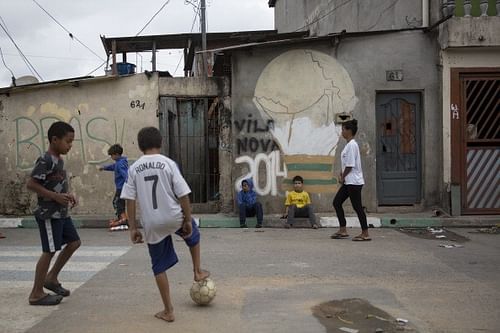
Why do the best strikers in world football come from South America?
The comfort and the ease by which we segregate things into categories is something that is unprecedented, perhaps the greatest thing since sliced bread even.
Football is not any different, it is a game riddled with stereotypes – German efficiency, Samba magic, Italian tactics, English Kick and Rush and lately Spanish tiki taka. Not just that we have even demarcated the kind of players that can come from a region; a central African box to box midfielder, a German goalkeeper, a Spanish creative midfielder, a marauding Brazilian wingback or a no-nonsense Italian centre back are the norms when we think of for these positions.
So much for priming the whole process of scouting and unearthing the next big thing in the football world, although questions regarding whether this is actually the way forward do regularly arise. Can we earmark places for producing footballing talent?
In 2014, Arsene Wenger went on record suggesting that South America has been able to deliver world class strikers time and time again in the recent past, basically trying to put forth the fact that street football and the likes have helped develop players and have also made them driven.
"When football is more formalised, it's less about developing your individual skill and fighting attitude. We've lost that a bit. Maybe it's because in Europe street football has gone. If you go back 30 or 40 years in England, life was tougher."
“We're much more protective and have all become a bit softer. In street football when you're 10-years-old, you want to play with 15-year-olds. Then you have to prove you're good, you have to fight and win impossible balls."
While Wenger, buoyed by Chilean Alexis Sanchez’s form for Arsenal, may have sounded a tad bit biased while making the above statement, the Frenchman does have a case for the generalised statement.
Looking at how Premier League is decked up with South American flair these days, with Chelsea still looking for their Brazilian (though officially Spanish) beast Diego Costa to deliver the goods, Aguero still going strong at Manchester City as their anchorman and Alexis again disrupting defences with his energy and pace, it is something worth reasoning.
Strikers from South America have incidentally taken over quite a few leagues other than the Premier League, including the La Liga (Lionel Messi, Neymar, Suarez), the Serie A (Higuain, Icardi and Tevez till 2014-15) and Liga Portuguesa (Porto being the purveyor of some of the biggest imports from South America in recent years).
So what are the reasons that set the Southern America apart from the rest of the world when it comes to producing strikers?
The Latin Game
One of the reasons that people attribute to this peculiar trend is the ‘Latin game’
The general notion of many is that South American players are good players of the ball. Most of them are flair players and tend to possess an openness towards pulling off skill moves while their sound technique aids them in their natural inclination to have the ball at their feet during a game.
Also, the presence of football-based sports like street football, beach football and futsal have all played a crucial role in creating some wonderfully gifted players.
But is this trait the only reason that makes the region, as the Brazilians like to say, ‘celeiro de craques’ or the storehouse for football stars? Perhaps not.
Historical factors and harsh realities
South American football has had some crude realities that have moulded ‘their’ style. The popularity of the game, the general lack of infrastructure and the common theme of poverty along with the lure of making it big at one of the European clubs is what motivates players to be sharper, stronger and hungrier on the pitch.
Beyond these macro issues that are always a mainstay of a great South American football story, there are cultural and historical factors that are again a key influence in building the brand of football we so often associate with the continent.
Historically, imperialism has had a huge say in bringing the game to the South American shores, but it was their own artistic interpretation of the game that has prevailed over all these times.
While their imperial master relied on technique and team skills, South American teams tried to defy them with an aesthetical football style that incorporated the individual panache and creativity along with a certain ingenuity, a street smartness or crude tactics that have always been an important insight when discussing Latin football; the darker arts that still do prop up in their game (a certain Luis Suarez and his spirit to win comes to mind).
Thus the whole concept of celebrating the game, again borrowing from the Brazilian vocabulary, Joga Bonito, or the beautiful game is what highlights the South American style. And no doubt some of these traits are what makes all these new age Latin strikers tick.
Success of the current crop

Looking at the current crop of South American strikers ruling the roost, much of these traits are finely perpetuated. The ability of the players to shape the game with their skill, speed and sturdiness has created a signature South American style in Europe.
Their sturdiness, in particular, is highly commendable; they possess an almost Rottweiler-esque intensity and force which they use to shrug off taller centre-backs. This is becoming an incredibly common sight these days, with the likes of Sergio Aguero and Lionel Messi managing to do so with relative ease despite their smaller frame.
So do we have a clear-cut answer to why are South American strikers doing so good? I doubt it. Should we call it a fad or an aberration and let it be? For sure not.
Like the initial bit, stereotypes can be major red herring in such cases.
While their ‘South American-ness’ has in a way prepared the basic framework for success, the globalisation of the game has also aided their rise to the top. The honing of skills and the scouting and academic groundwork at various clubs is also a very critical part of the process.
A very good example of such a case is Lionel Messi, who left Argentina at the tender age of 14 to develop his career at Barcelona’s famed La Masia academy. The diminutive forward has more or less had an equal influence of Argentinian and Spanish football over the course of his footballing education, which has helped him become the player he is today.
Conclusion
It is surely synergy that drives the process when it comes to producing a new age super striker. And we can see that the head-start given by a continent doped with the passion for the beautiful game is something that makes discovery and development of world-class players a lot easier.
No matter how much we discuss European football and its infrastructure, certain things are beyond the surface – technique and drills. These are the things that drive the player, things that are far more visceral than you can ever imagine, things that perpetuate the stereotypes and build a dynasty based on it making the favelas and villas of Southern America the hotbed for football prodigies.

